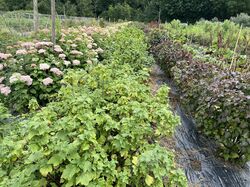 This week (calendar week 26) it was that time again, when the blackcurrants – also known as 'cassis' in some regions – were ripe and ready to be evaluated. In addition to raspberries and rhubarb, blackcurrants have been among the crops that have to be assessed every year for several years now. Some readers will be wondering why this is the case. The answer is easy to find. Blackcurrants have much more to offer than the small, sour and tart fruits from grandma's garden, which were only useful for processing. The focus of my statement is clearly on the little word 'were'. In recent years, Lubera breeding has taken blackcurrants to a whole new level. And that's not the end of it, as I was able to discover once again.
This week (calendar week 26) it was that time again, when the blackcurrants – also known as 'cassis' in some regions – were ripe and ready to be evaluated. In addition to raspberries and rhubarb, blackcurrants have been among the crops that have to be assessed every year for several years now. Some readers will be wondering why this is the case. The answer is easy to find. Blackcurrants have much more to offer than the small, sour and tart fruits from grandma's garden, which were only useful for processing. The focus of my statement is clearly on the little word 'were'. In recent years, Lubera breeding has taken blackcurrants to a whole new level. And that's not the end of it, as I was able to discover once again.
The 2024 cassis assessment – finally, in a second attempt
Originally, it was even planned to carry out this evaluation two weeks ago. At this point, the fruits were already beautifully black in colour. The fruits also felt soft and ripe when they were picked. But the rude awakening came when we tasted the fruit. There was no longer any trace of the soft feel. When biting into them, the fruit suddenly felt firm and not very juicy. The reason quickly became clear after the third/fourth try. Despite their outward appearance, the fruits were simply not ripe yet. So we had to be patient.
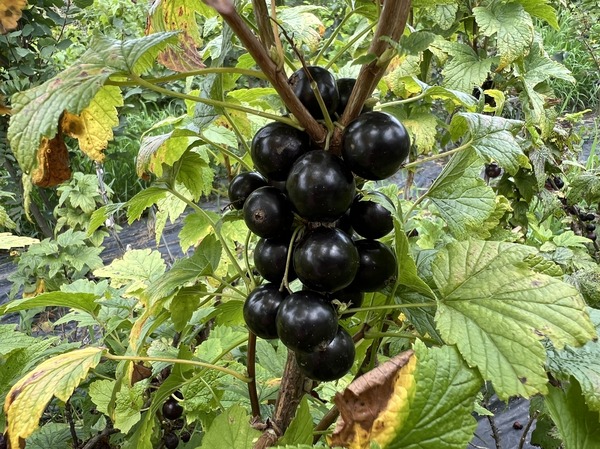
Picture: Cassis selection with large and sweet fruits - and most of all ripe fruits...
But this week the time had come: the fruits were already slightly past their peak of ripeness, but there were still more than enough in an ideal state of ripeness for a meaningful tasting. I usually do such a tasting directly in the field, on the plant. All data, notes and comments are recorded directly using a tablet and breeding app. The following points in particular are taken into observation:
- Length of the strings: different to red/white currants (Ribes rubrum), blackcurrants have mostly shorter strings; a potential new variety should already have a certain string length
- Size of the individual fruit: with this criterion, we have now reached the size of blueberries; we are currently at around 20 mm fruit diameter for certain varieties and selections
- Fruit quality: this point basically refers to the taste; the taste in general as well as the noticeable ratio between acidity and sugar – a balanced ratio creates a fresh and fruity flavour; however, under this point, I also rate the intensity of the typical 'cassis' aroma of blackcurrants – which not everyone likes (including me 😉)
- Potential: Each selection is finally evaluated according to its potential; is it a possible candidate variety or only to be used for breeding because a certain aspect stands out very positively
- Brix value: sugar content of the fruit, determined by a refractometer
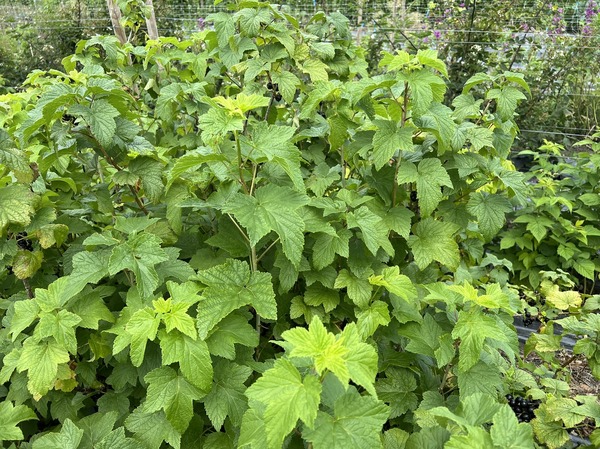
Picture: This is what you like to see when evaluating. A selection with exceptionally healthy foliage.
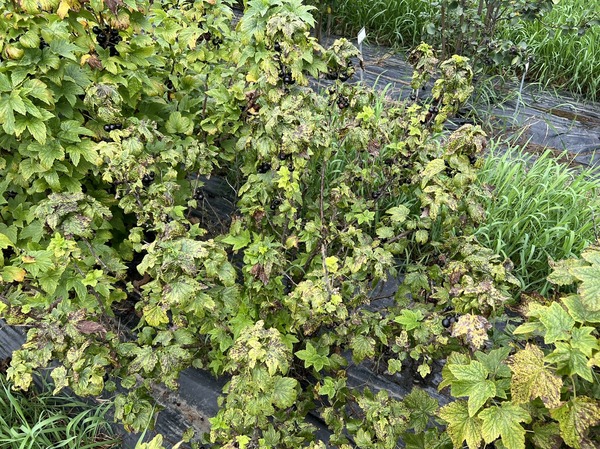
Picture: Occasionally, such a picture can also be seen. This is what needs to be recorded and sorted out in the annual evaluation.
The Brix value of blackcurrants
This year, I didn't just evaluate the tasting data – sometimes perhaps too subjectively. In addition to the tasting data, the Brix value was also measured and recorded. The Brix value is ultimately nothing more than the sugar content of the fruit, expressed and recorded in degrees Brix. For this purpose, the juice of the fruit – only the juice – is dripped onto a refractometer. Using light refraction, the Brix value can then be read very easily on an internal scale. All that is actually needed for this work is some fruit juice and daylight – and of course a refractometer.
It is true that a one-off Brix value determination is not very meaningful, especially since the weather during ripening was anything but optimal – too little sunlight, too little heat, far too much rainfall. Nevertheless, the relative difference between two selections should have a certain significance and in years with better weather conditions this relative difference should also be recognisable. However, we will have to wait until next year for this.
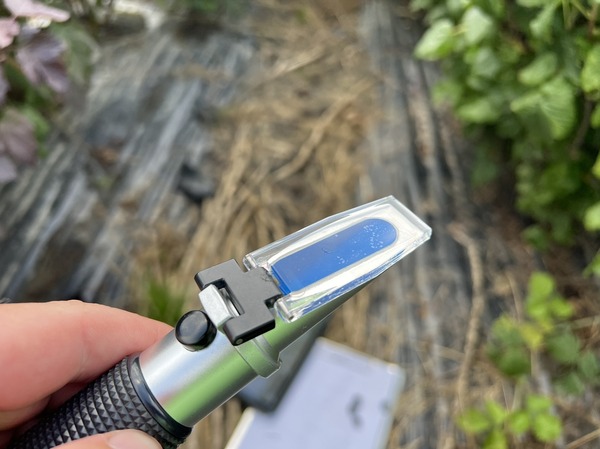
Picture: A standard refractometer for measuring the Brix value – the sugar content of the fruit.
Conclusion
In conclusion, it can be said that the breeding of blackcurrants at Lubera is going in the right direction – the fruits are becoming larger, sweeter and milder (less of the typical cassis flavour). Two prime examples of this are the already established varieties Cassissima® 'Blackbells'® and Cassissima® 'Black Marble'®. Both varieties are – both in terms of flavour and fruit size – currently the best that Lubera breeding has to offer and also worlds better than the well-known 'Titania' variety.
There are definitely candidates in the current plant population that come close to the two varieties. The coming years will show whether these are also worthy candidates.
